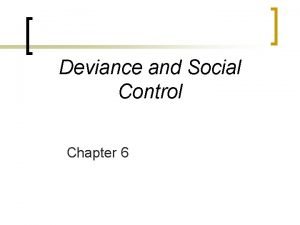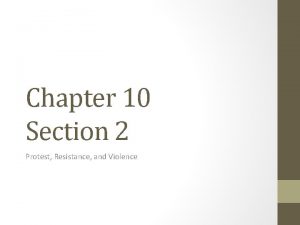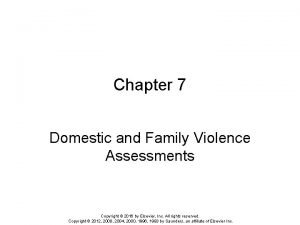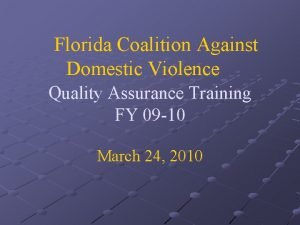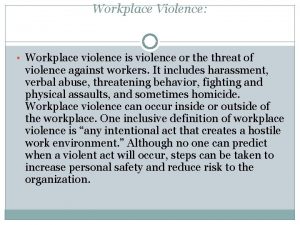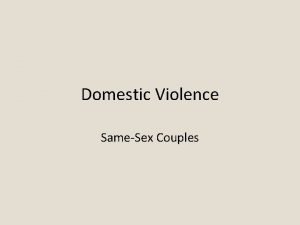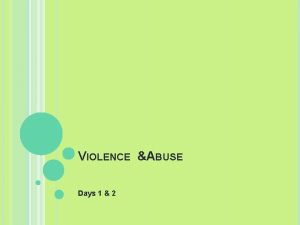Chapter 11 Crimes of Violence Chapter Summary Chapter




































- Slides: 36

Chapter 11 Crimes of Violence

Chapter Summary ü Chapter Eleven is an overview of the most prominent violent crimes in the United States and world wide. ü The chapter begins with an explanation of homicide and a comparison of homicide rates in the United States compared with the rest of the world. ü Chapter Eleven then discusses the crime of rape, and the main theories associated with the crime of rape.

Chapter Summary ü This is followed with a discussion of robbery and aggravated assault. ü The Chapter concludes with different theoretical explanations of crimes of violence. ü After reading this chapter, students should be able to: ü Explain homicide ü Understand the various theories of rape ü Evaluating theories of rape

Chapter Summary ü Discuss robbery ü Explain aggravated assault ü Understand theories regarding crimes of violence ü Discuss the implications of violence

Murder ü The FBI defines murder as: “The willful (non -negligent) killings of one human being by another. ”

Table 11. 1 Violent Crime Rates and State Rank in 2004 State Total Violent Murder Rape Robbery Aggravated Assault (22) 426. 6 5. 6 38. 5 133. 4 249. 1 Alaska (7) 634. 5 5. 6 85. 1 68. 2 475. 6 Arizona (13) 504. 1 7. 2 33. 0 134. 4 329. 4 Arkansas (15) 499. 1 6. 4 42. 4 86. 2 364. 1 California (9) 551. 8 6. 7 26. 8 172. 1 346. 3 Colorado (25) 373. 5 4. 4 42. 5 81. 5 245. 1 Connecticut (34) 286. 3 2. 6 20. 7 120. 5 142. 6 Delaware (12) 568. 4 2. 0 41. 5 146. 7 378. 1 35. 8 40. 1 578. 5 716. 9 Alabama Rank District of Columbia 1, 371. 2 Florida (2) 711. 3 5. 4 38. 0 172. 4 495. 5 Georgia (19) 455. 5 6. 9 27. 0 154. 7 266. 8 Hawaii (39) 254. 4 2. 6 26. 4 74. 8 150. 7 Idaho (42) 244. 9 2. 2 40. 9 17. 2 184. 6 Illinois (10) 542. 9 6. 1 33. 2 177. 2 326. 4 Indiana (29) 325. 4 5. 1 28. 9 102. 2 189. 2 Iowa (37) 270. 9 1. 6 26. 7 38. 0 204. 5 Kansas (24) 374. 5 40. 4 66. 3 263. 4 Kentucky (41) 244. 9 5. 7 29. 9 78. 8 130. 5

State Louisiana Rank Total Violent Murder Rape Robbery Aggravated Assault (6) 638. 7 12. 7 35. 8 145. 4 444. 9 (49) 103. 5 1. 4 23. 9 21. 9 56. 3 (3) 700. 5 9. 4 23. 7 229. 6 437. 8 Massachusetts (18) 458. 8 2. 6 28. 0 116. 4 311. 7 Michigan (17) 490. 2 6. 4 54. 2 111. 9 317. 7 Minnesota (38) 269. 6 2. 2 41. 6 79. 8 146. 0 Mississippi (32) 295. 1 7. 8 40. 0 86. 2 161. 1 Missouri (16) 490. 5 6. 2 25. 7 115. 2 343. 4 Montana (33) 293. 8 3. 2 29. 5 25. 1 236. 0 Nebraska (30) 308. 7 2. 3 35. 5 65. 1 205. 8 (8) 615. 9 7. 4 40. 9 210. 1 357. 6 New Hampshire (47) 167. 0 1. 4 35. 3 38. 5 91. 8 New Jersey (26) 355. 7 4. 5 15. 3 150. 3 185. 6 New Mexico (5) 687. 3 8. 9 54. 6 108. 3 515. 5 New York (21) 441. 6 4. 6 18. 8 174. 3 244. 0 North Carolina (20) 447. 8 6. 2 27. 4 137. 9 276. 2 North Dakota (50) 79. 4 1. 4 25. 1 6. 1 46. 8 Ohio (28) 341. 8 4. 5 40. 5 153. 1 143. 6 Oklahoma (14) 500. 5 5. 3 44. 2 87. 7 363. 3 Maine Maryland Nevada

State Rank Total Violent Murder Rape Robbery Oregon (31) 298. 3 2. 5 35. 7 76. 5 183. 6 Pennsylvania (23) 411. 1 5. 2 28. 5 148. 9 288. 4 Rhode Island (40) 247. 4 29. 6 67. 6 147. 7 (1) 784. 2 6. 9 40. 9 129. 7 606. 7 (46) 171. 5 2. 3 43. 8 14. 8 110. 5 Tennessee (4) 695. 2 5. 9 37. 6 149. 8 501. 8 Texas (11) 540. 5 6. 1 37. 3 159. 3 339. 9 Utah (43) 236. 0 1. 9 39. 1 51. 7 143. 3 Vermont (48) 112. 0 2. 6 24. 4 12. 2 72. 7 Virginia (35) 275. 6 5. 2 23. 7 92. 6 154. 1 Washington (27) 343. 8 3. 1 46. 1 94. 6 200. 2 West Virginia (36) 271. 2 3. 7 17. 6 42. 3 207. 6 Wisconsin (45) 209. 6 2. 8 20. 6 73. 8 112. 4 Wyoming (44) 229. 6 2. 2 22. 1 13. 2 192. 1 South Carolina South Dakota Aggravated Assault Source: Federal Bureau of Investigation (2005). Crime in the United States, 2004: Uniform Crime Reports. Washington, DC: Government Printing Office. Note: We did not include District of Columbia for ranking purposes.

Homicide Trends in the United States in the Twentieth Century ü We should never take national statistics at face value unless we are very sure of their quality. ü The homicide statistics of individual cities are more reliable. ü With the advent of the UCR in 1930, national data became somewhat more reliable.

Homicide Trends in the United States in the Twentieth Century ü The decrease in the homicide rate in the early 1990 s can be attributed to several factors including a large decrease in the crack market and in gang warfare as territories became consolidated by the strong pushing out the weak. ü Perhaps the biggest factor in the homicide drop has been the medical and technological improvements.

Figure 11. 1 Homicide Rates in the United States in the 20 th Century Source: National Center for Health Statistics. (2002). Vital statistics. Washington, DC: U. S. Department of Health and Human Services.

Categories of Murder ü First degree murder is defined today as the intentional unlawful killing of one human being by another with premeditation and deliberation. ü Felony murder does not require the intention to kill, bit rather the intention to commit some other felony during the commission of which a victim was killed. ü Voluntary manslaughter: The intentional killing of another human being without premeditation and deliberation.

Categories of Murder ü Involuntary manslaughter: Criminal homicide where an unintentional killing results from a reckless act. ü Negligent manslaughter: An unintentional homicide that is charged when a death or deaths arise from some negligent act that carries a substantial risk of death to others.

Stranger, Acquaintance, Family Member: Who Kills Whom? ü The typical homicide victim and perpetrator is a young black male living in a large urban center. ü When females kill males, it is typically a spouse, ex-spouse, or boyfriend in a self-defense situation.

Stranger, Acquaintance, Family Member: Who Kills Whom? ü The typical explanation for intrafamily homicide is that family members are in danger of being assaulted by other family members simply because they are frequently in “social distance” of one another. ü Non-genetically related family members such as spouses, stepchildren, and stepparents are at elevated risk for victimization.

Figure 11. 2 Homicide Victimization for Years 1976 -2002 by Age, Gender & Race Source: Homicide trends in the U. S. Bureau of Justice Statistics. (2004). Homicide trends in the U. S. Retrieved from http: //www. ojp. gov/bjs/homicide/tables/varstab. htm

Other Violent Crimes ü Although murder is the most serious of the violent crimes, it is the rarest.

Figure 11. 3 Violent Crime Victimization Rates per 1, 000 Persons Age 12 or Older From 1973 to 2003 Note: Data collected before the National Crime Victimization Surveys (NCVS) redesign was implemented during 1992 (the lightly shaded area) have been made comparable to the postdesign NCVS. Data were reestimated to account for the effects of the redesign. Rape does not include sexual assault for this trend analysis.

Rape and Rapists ü Forcible rape: The carnal knowledge of a female forcibly and against her will. ü Rapes of males are classified as either assault or other sex offenses.

Rape and Rapists ü The 16 -24 age groups were most likely to be victimized; women with household incomes less than $7500 per year were most likely to be victimized; Women who were divorced or separated were most likely to be victimized.

Rape Internationally ü The reported rape rate in the United States is typically four times higher than that of Germany, 13 times higher than Britain’s, and 20 times higher than Japan’s. ü Determining true rape rates is extremely difficult, and comparing international rape rates is more difficult yet.

Theories of Rape ü The three main theories of rape are the feminist, social learning, and evolutionary.

Feminist Theory of Rape ü Rape is motivated by power not sexual desire. ü Males are indirectly socialized to rape via gender role messages asserting male authority and dominance over women. ü Rape “is nothing more or less than a conscious process of intimidation by which all men keep all women in a state of fear. ”

Social Learning Theory of Rape ü Social learning places less emphasis on sexual politics and is generally agnostic about what the ultimate purpose of rape is. ü Social learning theorists agree with feminists that the negative images of women as the sexual playthings of men promulgated in advertising and pornography play a critical role in the rape causation. ü Social learning theory attempts to explain rape at the individual level.

Evolutionary Theory of Rape ü Some evolutionary theories of rape hold the view that coercive sexuality is a normal male strategy designed by natural selection. ü Forced copulation is observed in many animal species and that the key is to understanding rape is the wide disparity in parental investment between the sexes. ü All men are potential rapists and men who employ coercive tactics do so because of environmental factors.

Evaluation of the Theories ü The main contribution of feminist theory is political and legal. ü The major problem area of feminist and social learning theories is the insistence that rape is a pseudo-sexual act. ü Critics argue that rape is a sexual act. ü Evolutionary theories receives the most criticism, especially since theory cannot explain instances of rape in which there is no possibility of reproduction.

Biosocial Theory of Rape ü The sex drive and the drive to possess and control motivates rape. ü The average sex drive of men is stronger than the average sex drive of women. ü Although the motivation for rape is unlearned, the specific behavior surrounding it is learned. ü Because of the neurohormonal factors, people will differ in the strength of their sex drives and in their sensitivity to threats of punishment.

Robbery and Robbers ü The UCR defines robbery as: “The taking or attempted taking of anything of value from the care, custody, or control of a person or persons by force or threat of force or violence and/or putting the victim in fear. ”

The Robbers ü Interviews of active street robbers show them to be the least educated, least conscientious, most fearless, most impulsive, and most hedonistic of criminals. ü Robbery is the perfect crime for those with a pressing and constant need for fast cash to feed a hedonistic lifestyle and who enjoy the rush that the crime affords them. ü With the exception of rape, robbery is the most “male” of all crimes.

Aggravated Assault ü The FBI defines aggravated assault as : “An unlawful attack by one person upon another for the purpose of inflicting severe or aggravated bodily injury. ” ü Aggravated assault is the most common felony violent crime.

Explaining Violence Sociologically: The Subculture of Violence Thesis ü Subculture of violence: A subculture in which the norms, values, and attitudes of its members legitimize the use of violence to resolve conflicts. ü Subcultural practices cannot be properly examined or understood without reference to the structural factors present in the larger society that led to their formation. ü Many African American scholars attribute the subculture of violence to slavery; this situation generated a tradition of settling differences without involving authorities.

Explaining Violence Sociologically: The Subculture of Violence Thesis ü The successful application of aggression is a source of pride. ü Other social scientists may attribute the extraordinary level of violence in the inner cities to a culture of poverty. ü Honor subcultures: Communities in which young men are hypersensitive to insult, rushing to defend their reputation in dominance contests.

Figure 11. 4 2001 UCR Violent Crime Rates by Race

Hormones, Brains, Violence ü Testosterone facilitates criminal or status striving behaviors. ü Testosterone levels fluctuate up and down in response to environmental circumstances. ü Variation in testosterone levels is often the consequence of successful or failed aggression.

Hormones, Brains, Violence ü Abused and neglected children raised in honor subcultures are likely to experience both elevated levels of testosterone and lowered levels of serotonin, a combination especially likely to result in violence. ü Impulsiveness is the proximate behavioral expression of a brain wired by consistent exposure to violence.

Evolutionary Considerations: What is Violence For? ü Evolutionary biologists assume that violence evolved to solve some set of adaptive problems. ü Natural selection has provided us with the ability to switch to a violence mode quickly when we have reason to believe that things we value may be taken from us. ü Violence may be in the nature of human males, but it is not the nature of human males.
 Street law chapter 9 crimes against the person
Street law chapter 9 crimes against the person What is embezzlement
What is embezzlement How does sociology interpret hate crimes
How does sociology interpret hate crimes Crimes habituais
Crimes habituais Iter criminis
Iter criminis What are the crimes against public order?
What are the crimes against public order? What are the crimes against public order?
What are the crimes against public order? How does ultranationalism lead to crimes against humanity
How does ultranationalism lead to crimes against humanity Conventional property crime
Conventional property crime Crimes militares em tempo de paz
Crimes militares em tempo de paz Crimes against society
Crimes against society What role do anthropologists play in solving crimes
What role do anthropologists play in solving crimes Deviant behavior
Deviant behavior Expressive violence definition
Expressive violence definition Match the word with the definition mug burglary
Match the word with the definition mug burglary Crimes contra a economia popular
Crimes contra a economia popular Cscw
Cscw Types of computer crimes
Types of computer crimes Types of computer crimes
Types of computer crimes Crimes sy
Crimes sy Strict liability in tort
Strict liability in tort Oj simpson bruno magli shoes photo
Oj simpson bruno magli shoes photo Strict liability crimes
Strict liability crimes Puritanical methods of punishment
Puritanical methods of punishment Chapter 9 lesson 3 understanding violence
Chapter 9 lesson 3 understanding violence Chapter 9 lesson 2 resolving conflicts
Chapter 9 lesson 2 resolving conflicts Chapter 27 anger aggression and violence
Chapter 27 anger aggression and violence Chapter 10 section 2 protest resistance and violence
Chapter 10 section 2 protest resistance and violence Chapter 9 resolving conflicts and preventing violence
Chapter 9 resolving conflicts and preventing violence Chapter 10 section 2 protest resistance and violence
Chapter 10 section 2 protest resistance and violence Chapter 7 domestic and family violence assessment
Chapter 7 domestic and family violence assessment Chapter 10 section 2 protest resistance and violence
Chapter 10 section 2 protest resistance and violence Indicators of potential workplace violence
Indicators of potential workplace violence What is ignorance in modifiers of human acts?
What is ignorance in modifiers of human acts? Conclusion of violence
Conclusion of violence Gun violence thesis
Gun violence thesis Florida coalition against domestic violence
Florida coalition against domestic violence












